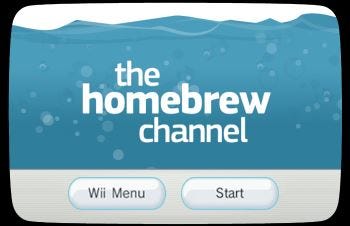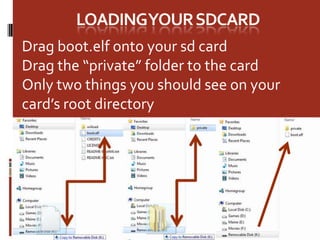
- How to run boot.elf from homebrew channel update#
- How to run boot.elf from homebrew channel code#
- How to run boot.elf from homebrew channel download#
removing the channel can be done with the channel management in the wii system software.Ģ. The Homebrew Channel is the new channel with no skin/theme.ġ. The installation should be automatic from this point on, and your Wii will reboot. READ THE DISCLAIMER! In the very unlikely case your Wii should be bricked by the installer, this will let you know where you stand in regards to Team Twiizers. Run the Twilight Hack, and allow the installer to load.ĥ. Place the installer file on the root of your SD card.Ĥ.
How to run boot.elf from homebrew channel download#
Download the installer from the section below.Ģ. Once the channel has expired, it cannot be reinstalled, so it's suggested you use the allocated ten minutes wisely.Īssuming the Twilight Hack is already installed on your Wii ġ. Currently it allows ten minutes of usage before expiring.

Currently the Wii Homebrew Channel available for public release is a beta. It allows homebrew to be run from the SD card in a similar fashion to the Twilight Hack, but from the Wii menu, so is more convenient. These files are generated during the "prepare SD card" steps.A custom Wii channel created by Team Twiizers, the same people responsible for the Twilight Hack.
How to run boot.elf from homebrew channel code#
Of course, the boot2 code is limited in size, so instead it loads certain files on the SD card instead. This allows it to execute some custom code before the Wii menu boots, meaning it can serve as brick protection. If your Wii is compatible, BootMii will replace the normal boot2 code. Unfortunately, Nintendo later patched boot1 on newer consoles, making those consoles always incompatible. Since boot1 cannot be modified, this means that any "BootMii as boot2" compatible Wiis will always be compatible. We can see that there are various "booting" steps that happen before the Wii Menu is executed (which is when the health screen appears).īoot0 is on read-only memory and can thus never be modified.īoot1 can be written, but various read-only checks prevent anyone from doing so.īoot2 however, can be modified on older consoles due to a bug in boot1 on those systems. The booting procedure of the Wii goes something like this: The NAND backup function can be found under the 4th button, then the 1st button (the highlighted button in the below screenshot). To make your Wii more brick-proof, make a backup of the NAND before making major changes to the Wii memory. You can navigate through the menu with a GameCube controller or the buttons on the Wii itself ( Power = right, Reset = OK). In the Homebrew Channel, press home to access the menu, and choose "Launch BootMii". If you only installed BootMii as IOS, you need to launch BootMii through the Homebrew Channel instead. Every time you boot the Wii with the prepared SD card inserted, you will see the BootMii menu.

IT IS HIGHLY RECOMMENDED THAT YOU CREATE A NAND BACKUP AS SOON AS POSSIBLE AFTER INSTALLING BOOTMII.

This backup can also be restored later on if needed, providing an additional brick protection. BootMii has the ability to dump this memory to the SD card (as the file NAND.bin). One of the features BootMii provides is the ability to create a NAND backup. This is why BootMii can't be installed as Boot2 on those Wii's. Unfortunately, Nintendo already knew about it before it was even released, so they updated boot1 (which loads boot2) on newer Wii's.
How to run boot.elf from homebrew channel update#
As boot2 is normally not updated through a wii system update (which was proven wrong with the 4.2 update!), this is the best brick protection you can get. BootMii is a modification of boot2, which loads the system menu when booting the Wii.


 0 kommentar(er)
0 kommentar(er)
